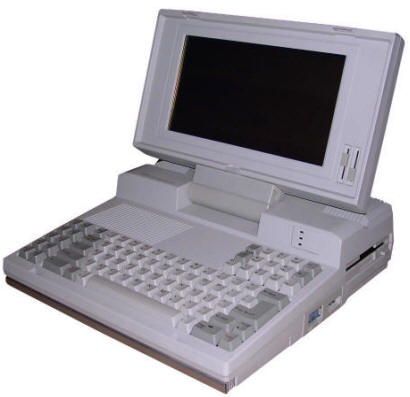Nec MultiSpeed HD
One of V30-based computers from late 1980s. This
portable PC is a complete laptop machine, with LCD screen, battery and
even 20MB hard disk. It is running with 10MHz Nec V30 CPU, compatible
with 8086 but more powerful. It has 640kB of RAM in SRAM chips, so no
energy is wasted in refresh logic as there is no refresh. Some memory
can be used for a RAM disk to work longer on a battery charge by turning
the hard disk off. Essential software: Text editor, communications
program, database, catalog and help system are stored in ROM so the
machine can work only with battery-powered RAM disk.
The computer has a nice CGA 8-shade grayscale backlit LCD with quite good
contrast. When working with external monitor, the screen can be detached
from the base unit to use the main unit as a larger keyboard.
This computer is a typical example of Japanese technology of late 1980s.
Most components are high quality SMD, soldered using good amount of
alloy to make sure that chip will not disconnect, and only chips which
may have to be replaced in customization are in through-hole packages
and sockets. Floppy disk drive made by Teac is a solid one with
cast-metal frame, so now it is working as well as it was working when it
left the factory. The fan has only bearing in the center and inductors
outside the rotor, so it doesn't make much noise if bearing is clean.
| Manufacturer | Nec | |
| Origin | Japan | |
| Year of unit | 1989 | |
| Year of introduction | 1988? | |
| Type | Laptop, PC | |
| CPU | Nec V30, 4.77/9.54MHz | |
| RAM | 640kb | |
| Floppy Disk | 1x 3.5", 720kB | |
| Hard Disk | 20MB, proprietary IDE-like standad |
|
| Other media | None | |
| Graphics and display: | CGA-compatible LCD, backlit, grayscale 8 shades. | |
| Sound: | PC Speaker | |
| Keyboard and pointing device: | Full-stroke PC keyboard with
separate numeric part working alternatively as cursors. |
|
| OS: | MS-DOS | |
|
Power supply: |
||
|
|
||
| I/O: | - Serial port - Parallel port - DB9 video out |
|
| Possible upgrades: | Probably some ROMs, 4 sockets available | |
| Additional peripherals: | Modem board inserted in its slot |
I don't know the history of my unit except that it has been sold in USA market. It is in quite good condition but the hard disk seems not to be detected. It has Amertech (refurbisher?) sticker and someone fixed broken LCD socket using a nut and bolt.
The hard disk, CMS LDSNECHD-20, seems not to be detected
at all even in other PCs (yes, the 40-pin connector looks more or less
ATA compatible, while the power connector is like these old connectors
on ST412 boards. It is
listed
here as AT Bus with auto-park, but IDE disks are not even spinning
up in the computer while this one needs a clear system's signal to
spin up. There is an interface converter which negates some signals from
34-pin connector. I think that this is not a full ATA, maybe even XTA
with ATA-like pinout. The computer has a hard disk park routine built in
BIOS, so powering it off will cause the screen to display "Parking drive
heads" and after this procedure the computer will turn off.
CMS, a company from Singapore
shut down ca. 1992, was not a good hard
disk manufacturer. They inherited some drives and technology from
Kalok/Xebec, they were even worse.
The computer has additional HELP and Pop-up keys. The idea of
"Pop-up" software was originationg from earlied Nec models, which
had two floppy disk drives and possibility to get a RAM disk. Some
applications are stored in ROM and menu with them is called when Pop-up key
is held for few seconds.
The memory by default is ca. 607kB. Yes, 607, it is not so unusual with
RAM disk.
The screen is detachable. To detach it, you have to open the small door in front of the screen's base (rotating part) by pulling it downwards, it opens for a small angle unlocking the display. Then just lift the display upwards to detach it.
I haven't experimented with it, but there is a character ROM on mainboard compatible with 27128, so maybe it is possible to add foreign characters support by patching it?
It is important to maintain or replace the small rechargeable battery in a mainboard, near modem. This is a conventional 3.6V one, which can be replaced with diode and CR2032 battery (a nice place to stick a CR2032 holder is the modem bay near modem's transformer). This battery may leak. It is responsible for backing up the RTC and SETUP settings at least.
Pinouts:
Hard disk power pinout:
1 2 3
4 5
1,3 - +5V DC
2 - +12V DC
4,5 - GND.
In a hard disk, there are 2x2 more pins not connected to power.
Functions unknown.
DIP Switches on the rear:
1 - Always OFF
2 - OFF reverses character attributes which makes text visible better.
3 - Always OFF.
4 - ON locks the CPU in 4.77MHz mode, OFF allows to switch between
4.77MHz and 9.54MHz.
On the boot disk (available in a
Nec MultiSpeed Website) (mirror) there
are other tools:
- COLD - returns to initial state, 607kB of RAM
- RAM640R, KILL640R - restores 640K of RAM. Built-in software may not
work.
- KILLPOP - turns the Pop-up key off.
- SETUP - configuration.
Help/Pop-up keys will not work if system is not booted from this disk
but from some other (tried with DOS 5.0 - no effect).
Links:
https://sites.google.com/site/thenecmultispeedinformatorium/home -
Nec MultiSpeed Site
http://www.thecomputerarchive.com/index.php?path=thearchive%2FComputers%2FPC+portables/
- They have advertisement of earlier MultiSpeed computer.






